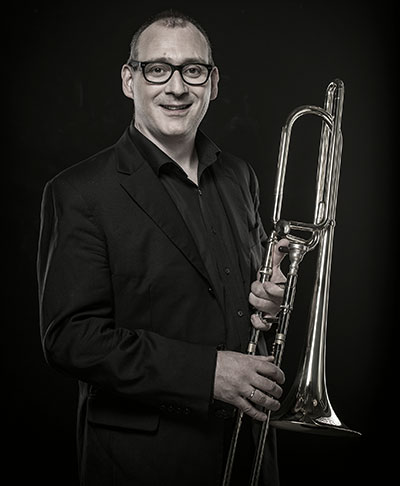Der harte Weg an die Orchesterpulte
Für die Stelle der zweiten Posaune bei den Wiener Symphonikern hatten sich 101, für das Pult der Solo-Flöte 239 Musiker_innen beworben. Zahlen wie diese zeigen einmal mehr: Die Konkurrenz ist enorm, der Druck ist hoch und die Jungen werden immer besser. Die eine oder andere Aufnahmemodalität mag sich zwar von Orchester zu Orchester unterscheiden, die Grundvoraussetzungen, Teil eines Klangkörpers zu werden, sind für alle gleich. Die wichtigste davon ist – auch wenn es wie eine Binsenweisheit anmutet – die bestmögliche Vorbereitung. Darüber sind sich Lehrende aus allen Instrumentengruppen einig. Lieke te Winkel, Konzertmeisterin des Tonkünstler-Orchesters Niederösterreich und seit 2011 Professorin an der mdw, bringt es auf den Punkt: Man müsse auf das Probespiel so gut vorbereitet sein, dass man sich selbst nichts vorzuwerfen habe. Freie Stellen werden in Orchestern nicht regelmäßig ausgeschrieben. Aber wenn dieser Tag X zur Realität wird, gilt es, bereit zu sein.

Die richtige Vorbereitung
Egal ob Streicher, Bläser oder Schlagwerker, die Bedingungen sind für (fast) alle gleich. Für jedes Instrument gibt es Stücke, die für ein Probespiel einzustudieren sind. Das Vorspiel verläuft bei allen Orchestern und in allen Instrumentengruppen nach einem ähnlichen Procedere. In einem Knock-out-Verfahren werden die Besten aus den Vorspielrunden von einer Jury, meistens bestehend aus Orchestermusiker_innen, ermittelt. Die ersten beiden Runden finden hinter einem Vorhang statt. Und hinter dem sind alle – Musikerinnen und Musiker – gleich. Wer die meisten Punkte in einer Runde bekommt, rückt in die nächste auf. Dass es noch immer weniger Frauen als Männer an die Pulte der großen österreichischen Orchester geschafft haben, liegt daran, dass diese erst seit 1986 bei den Wiener Symphonikern und seit 1997 bei den Wiener Philharmonikern auch Musikerinnen offenstehen.
Für alle aber ist dieses Vorspiel eine fordernde Nervenprobe. Oliver Madas, Schlagzeuger der Wiener Philharmoniker, wurde 2008 als Professor an die mdw berufen. Sein Vorspiel bei den „Wienern“ liegt mehr als zehn Jahre zurück. Damals hat er mit autogenem Training auf den Tag X hingearbeitet. Heute werde das mentale Training junger Musiker_innen von Spezialist_innen übernommen. Die Anforderungen an Schlagwerker_innen sind besonders hoch, erklärt er. Anders als ihre Kolleg_innen müssen Musiker_innen an den Schlagwerken mehrere Instrumente beherrschen: neben den Kerninstrumenten, wie kleine Trommel und Pauke, auch Melodieinstrumente wie Vibraphon oder Marimbaphon. Dazu kommen noch Handinstrumente, wie etwa Becken, Tamburin, Triangel und lateinamerikanische Instrumente.

Eines aber gilt für alle, man muss wissen, was in einem Orchester und auch auf einer Musiktheaterbühne während der Aufführungen passiert. Das erreicht man am besten, indem man sich immer wieder Aufnahmen anhört – egal ob von symphonischen Werken oder Opern. „Das hilft, ein Gefühl für Klang, Tempo und Phrasierungen zu entwickeln“, erklärt Te Winkel. „Am besten mit der Partitur“, ergänzt Madas. Unabdingbar ist es, so früh wie möglich Erfahrungen in verschiedenen Orchestern zu sammeln. Denn nur dort lernt man nach dem Prinzip „learning by doing“ das Grundsätzliche, nämlich Dirigent_innen zu folgen. „Das kann man nur in der Praxis üben“, sagt Otmar Gaiswinkler, 1. Posaune bei den Wiener Symphonikern und ebenfalls Lehrender an der mdw, „egal ob in Hochschul- oder im Idealfall in Jugendorchestern wie dem renommierten Gustav-Mahler-Jugendorchester und dem European Union Youth Orchester, um nur einige zu nennen.“ Empfehlenswert sei es auch, als Substitut_in oder Praktikant_in bei Profi-Orchestern unterzukommen, meint Te Winkel.
Teamplayer
Keineswegs zu unterschätzen ist die Probezeit. Das sind die wirklich alles entscheidenden ein bis zwei Jahre. Man muss in dieser Zeit ständig an sich selbst arbeiten, um sich klanglich und im sozialen Gefüge des Orchesters zu integrieren. Man muss bedenken, dass man permanent mit 80 bis 90 Personen gleichzeitig am Podium sitzt. Mit den Kolleg_innen in nächster Nähe muss man beim Musizieren genauso gut zusammenfinden, wie mit Kolleg_innen, die 20 bis 30 Meter entfernt sitzen. „Das ist eine Herausforderung“, sagt Madas. „Jede Probe sollte man stets gut vorbereiten“, ergänzt Te Winkel.

Für den Verbleib im Orchester ist aber keineswegs nur Qualität entscheidend. „Gute Instrumentalist_innen müssen sich auch in ein Kollektiv einfügen können“, sagt Gaiswinkler. Ob das funktioniert, sehe man meistens erst in der Praxis. In manchen Gruppen, wie bei den Streichern, sind Teamplayer mehr gefragt als etwa bei den Solo-Flöten, führt Gaiswinkler als Beispiel an und fügt hinzu: „Doch auch an dieser Position muss man teamfähig sein.“ Die beste Technik und die optimale klangliche Integration helfen letztlich nichts, wenn die zwischenmenschliche Chemie nicht stimmt. Denn Uneinigkeiten und Streitereien kosten nur unnötige Energie. „Man muss mit Kolleg_innen so zusammenarbeiten, dass jede_r ideal spielen kann“, bringt es Gaiswinkler auf den Punkt.
Denn nur dann könne das entstehen, was Lieke te Winkel für das Schönste beim gemeinsamen Musizieren hält: „Das sind die Momente, wo Klang, Musik, Orchester und Publikum zu einer Art Einheit werden. Jeder Klang fühlt sich richtig an und keine_r weiß, warum.“ Und das lohnt jede Mühe.

